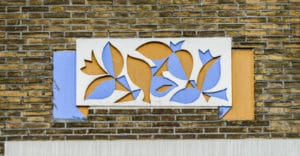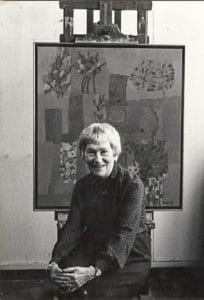Every city in the Netherlands has artists who enjoy local fame and glory but just beyond the city limits yield only questioning looks. Take the Goeting family of painters from The Hague. They are Jan Goeting (1918-1984), his wife Catharina (1912-1987) and son Joep (1946-1986). The nice thing about this family is: every Hagenaar or Hagenees over 55 knows a lot of work by at least Jan Goeting. Only: he or she does not know it.
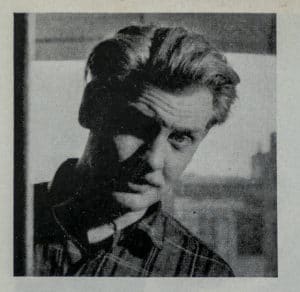
Kissed awake
The Goeting heirs, sister and brother Petra and Jan Willem Evers, uncle-sisters of Jan Goeting, have reawakened the paintings, tapestries, plastics, children's books and etchings of Jan, Catharina and Joep by organising an exhibition in the stately Wassenaar Town Hall de Paauw. 'Out of the shadow of history, into the light of today', they call it themselves.
Wormhole to youth
I was among the gullible. On 8 December, a day after the opening, I drove to Raadhuis de Paauw as an older youngster from The Hague with tempered expectations. Inside, it was like crawling back to my childhood through a wormhole. Back to the Sixties and Seventies. I looked at the display cases with booklets full of work by (mainly) Jan Goeting and got déjà vu as fresh as an oven bun. Jan Goeting is the man of the gable stones above the archetypal Hague porches and portals on Sportlaan, Scheveningen's Oranjeflats and Monnikendamplein. I cycled past them for years on my way to school, the beach or dancing and didn't bat an eyelid.
Jan Goeting is the man who - together with his wife Catharina - drew for countless facade mosaics and ceramic plastics on exterior and interior walls of many buildings in The Hague. The wall with beautiful brick mosaic of the Marcuskerk on Jan Luykenlaan around the corner from me, I was blind to it.
Solid ANWB building
The worst thing: Jan Goeting - with his Catharina - is the man who brightened up the solid, brick Hague ANWB headquarters with ceramic-glazed tiles and bricks in primary colours, with symbols of day, moon, fish and sun symbols, masonry based on a gigantic drawing that Jan had hung full-size behind the masonry. A head gable with a huge hand, to represent the serving and protective role of the ANWB. Goeting applied mosaics with delightful birds under no less than 600 windows.
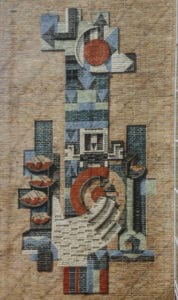
For about 20 years, working at ANWB Media, I walked along the facades during breaks with the eyes with which I ate bread. I saw nothing, but my soul registered. In short: The Hague is truffled with artworks by Jan and Catharina Goeting but you have to be up to it....
Full cousins
Petra and Jan Willem Evers are cousins of Jan and Catharina and full cousins of their son Joep. Petra: 'I attended the same primary school with Joep.' The sister and brother, warm-hearted and unaffected people (like many Hagenaars outside the Benoordenhout area, for that matter) were soaked in Uncle Jan and Aunt Catharina's artistic world at an early age: 'Uncle Jan was our favourite uncle, a sociable, kind man. As children, we would often visit them on Van Imhoffstraat, where they lived. But not during the day, because there was a sign on the door saying "Between 10 and 4, don't call", then they were working.'
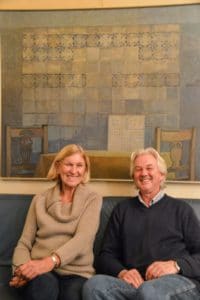
Tackling everything, not a fat lot
Jan Willem: 'Uncle Jan and Aunt Catharina were hard workers. In the beginning, they had to deal with everything; art was not a fat lot.'
He shows a black-and-white photograph of Metropole Palace, the legendary cinema on Laan van Meerdervoort. Jan Willem: "This huge advertising banner on the façade was also painted by Uncle Jan, for a film about the royal family.
Petra: 'I want to be an artist, Uncle Jan told his parents at the time. He then heard that he was then doomed to die poor. But he was allowed to go his way.
In new cars to Italy
'Later, Jan and Catherina made a good living from it. They earned quite well. The introduction of the 1% scheme gave them numerous monumental commissions, they had rich clients from 't Gooi. They celebrated their successes with a happy life, drove to Italy in new cars, they lived well. So did their son Joep later.

Jan Willem: 'That portrait of Dr Ong, it hangs in the exhibition, cost 20 thousand guilders thirty years ago. They were quite expensive, even in their time. They regularly had clients from the Gooi region.'
Tough fifties head
Jan Goeting was a beautiful, dashing man. Petra and Jan Willem open one of the many family albums with black-and-white photos from the last century. Uncle Jan looks into the lens with a cool fifties head, his crest could easily be in Gerard Reve's The Evenings. Goeting was part of the Nieuwe Haagse School, a movement in visual art from the 1950s and 1960s. Characteristics: resistance to the Cobra movement, inspiration in 17th-century art, the Barbizon School and the resulting Haagsche School. It was innovation in a Hague style. In 1949, the so-called Posthoorn Group was formed, named after the famous bodega De Posthoorn, still glorious today.
Many artists from groups such as Atol, Fugare or Verve exhibited at the Gallery on Lange Voorhout between 1956 and 1962. Well-known names were Kees van Bohemen and Jan Cremer. Non-members Paul Citroen and Piet Ouburg also belonged to the Nieuwe Haagse School.
How Hague-based were the Goetings?
Petra and Jan-Willem: 'Superhaags. They were born here, lived here. Jan Goeting trained at the Royal Academy of Art in The Hague. Was a member of Pulchri Studio and the Haagse Kunstkring. He worked as a teacher at the Academy. In 1947, he won the Jacob Maris Prize, an art prize awarded by The Hague Salon in the Pulchri Studio was awarded to artists from The Hague.'
Advertising

Petra and Jan-Willem: 'These people were not advertising themselves. They did not advertise themselves enough. Jan was just a very nice man, Catherina and he were fond of each other, they did all kinds of fun things with Joep and us, on holidays all the material went with them in the car, the art just went on.'
Jan Goeting was also known as a portrait painter and portrayed many prominent figures and artists. A highlight of Jan Goeting's artistic life was undoubtedly the commission for the portraits of Princess Beatrix and Princess Christina, for the national gift to Queen Juliana in 1976. Jan travelled to New York for a working visit to Princess Christina and Princess Beatrix personally came to the - completely cordoned off - Van Imhoffstraat to pose.
Jan Willem: 'We still wanted to hide in the attic, but unfortunately we were not allowed to.'
Mondrian motif
At the (small) exhibition in de Paauw is a portrait of Prof L.J.F. Wijsenbeek, the then director of the Gemeentemuseum. Smiling and with a visionary Mondrian motif in front of him on the table. The portrait of Prof Dr Ong, a doctor, a portrait of his

wife Catherina and one of Catherina and young son Joep. No stately portraits, but mostly people caught in the action and spirit of the moment. The somewhat cubist, almost archetypal image of the 1960s American tourist, surrounded by cameras, is special. It is also there in ceramics and sat/sat in gouache as a kind of preliminary study in a folder (not any more, by the way: writer dezes bought the piece quickly and eagerly).
Oelie and Djum from 1946
Scattered across the three rooms are graphics, watercolours and tapestries by Catharina. By son Joep (who received his training at the Academy of Visual Arts in Arnhem and in Amsterdam), gouaches, ceramics and some paintings can be seen in Raadhuis De Paauw.
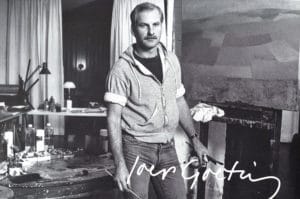
In 1946, Jan Goeting did the illustrations in the children's book Oelie and Djum. Beautiful, simply stylised, in two colours; a bit Fiep Westendorp-like. The booklet would not survive the zeitgeist of 2017. Read this excerpt, for example:
'Amid thunderous applause and music, a little girl is ushered into the room. It is a sweet little blackhead,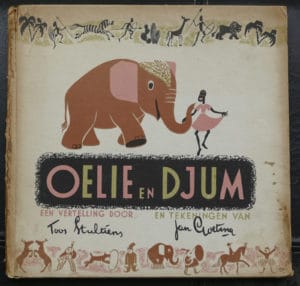 a negro girl with curly jet-black hair and dark eyes...'
a negro girl with curly jet-black hair and dark eyes...'
Ah-erlebnis in third showcase
Another ah-er experience in the third showcase. A book shows images of the large mosaic in the council chamber of Hengelo town hall, designed by Jan and Catharina from marble and natural stone. Bright colours, basic figures, thick symbolism of sun, rooster and owl, surrounded by jar-shaped scenes of the naked, thirsty, hungry and children in need of care and protection.
Reconstruction art. Temporal images in a form you could (still) come across on and in Hague apartment buildings, Hague training schools, bank buildings, or in the Shell headquarters. Goeting was the décor of my childhood. Seen then, but not noticed.
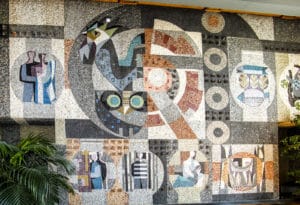
'It must be art again,' you thought at the time. But you couldn't name it in a time without TV and internet.
'Everything is for sale'
Petra and Jan Willem: 'By no means everything hangs here. In our house, hundreds of artworks by Jan, Catharina and Joep were stored, large and small. Our mother inherited from Jan and Catharina, we inherited from Joep. We first gave the works to an institute, which didn't work out, they gave everything back to the family.
Jan Willem: 'Inheriting is nice, but it is also a burden. You can't put it on shelves and do nothing else with it. It has to be seen, out in the world. We kept the personal works. Jan painted our lives, you didn't take many pictures in those days.' 'Other than that, everything is for sale,' says Petra. 'We've already sold through art dealers and to the Municipality of Wassenaar, but it's quite difficult, especially the pricing.'
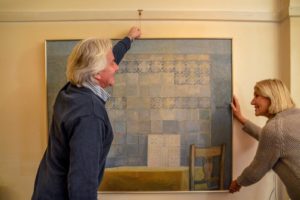
The entire Goeting family of painters discharged within a mere three years. Jan Goeting died of cancer at the age of 66 in 1984. Son Joep was 40 when he died of AIDS in 1986. Mother Catharina Goeting died at 74 in 1987.
'Of sadness,' says Petra Evers.
'The Goeting family of painters' has become a small, fine exhibition spread across three garden rooms of the snow-white Council House de Pauw. Address: Raadhuis De Paauw, Raadhuislaan 14, Wassenaar. The exhibition runs from 8 December 2017 to 21 January 2018 and is free to visit on Thurs, Fri, Sat and Sun from 12.00 -16.00. www.goeting-art.com is the official site of the Goeting heirs.
